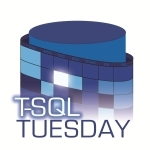Jen McCown (Twitter) of Midnight DBA is the guest host for this month’s SQL blogger event known as T-SQL Tuesday (#TSQL2sday) which was started almost 6 years ago by Adam Machanic. This month, Jen has assigned us the topic: Strategies for Managing an Enterprise. Jen will be doing a wrap-up summary of all blog posts submitted on this topic per the rules and I’m looking forward to everyone’s input on this subject.
I’ve been presenting a session for the past several years at SQLSaturday events entitled “Managing SQL Server in the Enterprise with TLAs”. The TLAs (three-letter acronyms) are CMS (Central Management Server), PBM (Policy Based Management) and EPM (Enterprise Policy Management Framework). I’ll be presenting this session at SQLSaturday #447 Dallas on Oct. 3rd, 2015, so you can come learn the details of these features then. But, per the assigned topic for this post, let’s focus on the “strategies” driving the usage of these features.
For me, one of the main goals in managing the enterprise is finding ways to reduce the effort in managing that landscape –whether two instances of SQL Server or two thousand instances. A strategy for getting there is organization. The CMS enables you to define groups to which you register your SQL Server instances and then you can perform tasks against those groups. Why perform a task per instance when you can do it for multiple instances at one time? The CMS is actually defined in tables in the msdb database of the designated instance. I would recommend having a dedicated “central management server” instance which you will use for CMS, PBM, EPM, and other administrative tasks.
With CMS, you can create many groups and register instances in multiple groups based on the tasks that you may want to perform against those groups. For example, you can create groups to organize by SQL Server version, by Production\UA\QA\Dev\Test, by Application, by location, and be sure to have one group with all your SQL Server instances registered to it. SQL Server Management Studio (SSMS) enables you to run “multi-instance” queries using a CMS group. That is, you execute the contents of the Query window against every server instance in the specified group and the results are returned to the SSMS console.
A second strategy in managing the enterprise is standardization. Policy Based Management enables you to define expected settings (e.g. conditions) and verify whether an instance of SQL Server meets those conditions. Examples of policies could be checking that the sa login is disabled or ensuring the AUTO_SHRINK option is off on all databases. My recommendation is to configure the policies on the same instance as your CMS groups (e.g. your dedicated central management server) so that you only have to manage one set of policies. Policy definitions are also stored in the msdb database. You will also want to export the policies to a central file server. Policies are exported as XML formatted files. When evaluating the policies on a specific instance, you may use either the central management SQL Server instance or the file server where they are stored as the source. SSMS also allows you to manually evaluate policies against a CMS group – returning all the results to your SSMS console.
The third strategy is automation. If you have a CMDB (Configuration Management Database), then you can utilize it as the source for populating your CMS groups by scripting the entire process to keep your CMS groups current with the CMDB contents and setting this up as a SQLAgent job to schedule as needed. Policies can be assigned to categories. The EPM Framework provides a mechanism (a PowerShell script) to automate the PBM evaluations by category against a specific CMS group and store the results for reporting. EPM requires a database repository to store the results, so again I recommend creating this database on a dedicated central management server. Once you’ve been through the exercise of setting up your CMS, establishing policies, and configuring the EPM Framework for your environment, you’ll see additional opportunities to utilize the CMS for automating other tasks.
So, start leveraging the CMS, PBM, and EPM features today to reduce your efforts by organizing your instances, increasing standardization, and automating tasks in your enterprise!
Filed under: SQL Server, T-SQL Tuesday | Tagged: Automation, CMS, Enterprise Management, Policy-Based Management, TSQL2sday |


